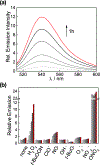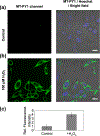A microtubule-localizing activity-based sensing fluorescent probe for imaging hydrogen peroxide in living cells
- PMID: 34245851
- PMCID: PMC8556696
- DOI: 10.1016/j.bmcl.2021.128252
A microtubule-localizing activity-based sensing fluorescent probe for imaging hydrogen peroxide in living cells
Abstract
Hydrogen peroxide (H2O2) is a major reactive oxygen species (ROS) in living systems with broad roles spanning both oxidative stress and redox signaling. Indeed, owing to its potent redox activity, regulating local sites of H2O2 generation and trafficking is critical to determining downstream physiological and/or pathological consequences. We now report the design, synthesis, and biological evaluation of Microtubule Peroxy Yellow 1 (MT-PY1), an activity-based sensing fluorescent probe bearing a microtubule-targeting moiety for detection of H2O2 in living cells. MT-PY1 utilizes a boronate trigger to show a selective and robust turn-on response to H2O2 in aqueous solution and in living cells. Live-cell microscopy experiments establish that the probe co-localizes with microtubules and retains its localization after responding to changes in levels of H2O2, including detection of endogenous H2O2 fluxes produced upon growth factor stimulation. This work adds to the arsenal of activity-based sensing probes for biological analytes that enable selective molecular imaging with subcellular resolution.
Keywords: Activity-based sensing; Fluorescent probe; Hydrogen peroxide; Molecular imaging; Reactive oxygen species.
Copyright © 2021 Elsevier Ltd. All rights reserved.
Conflict of interest statement
Declaration of Competing Interest
The authors declare that they have no known competing financial interests or personal relationships that could have appeared to influence the work reported in this paper.
Figures







